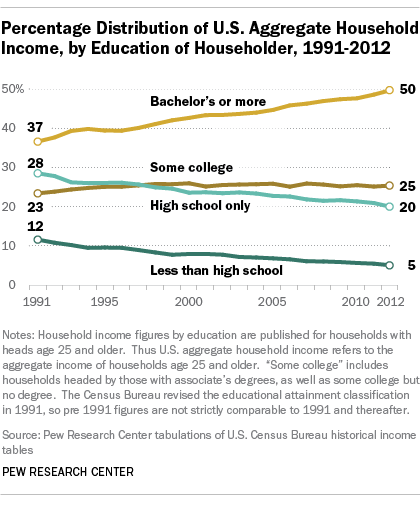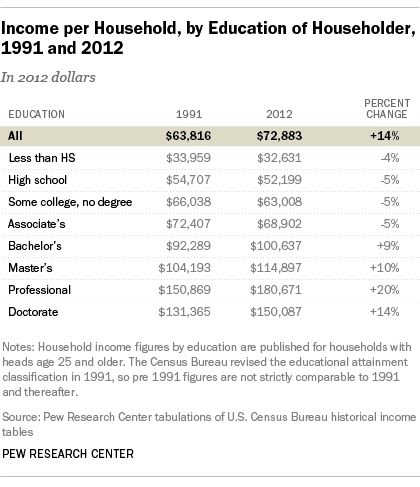Last week’s data released by the Census Bureau vividly demonstrated the growing income inequality in the U.S. But deeper in the data, there’s another related finding that is also striking: The growing income accruing to the nation’s college-educated households.

For the first time on record, households headed by someone with at least a bachelor’s degree received nearly a majority (49.7%) of aggregate U.S. household income; nearly one out of every two dollars went to the college educated. In 2012 one-in-three households was college educated, so, put another way, half of the aggregate U.S. income goes to one third of the households.
In 1991 (the earliest year comparable figures are available) college-educated households only received 37% of the nation’s aggregate income. In 1991 about one-quarter of households (23%) were college educated.
The share of the income pie received by households with only a high school education or less fell 15 percentage points from 1991 to 2012. The share of household income going to households with some college (including those with an associate’s degree) increased modestly over the same period (23% to 25%).
Since educational attainment has risen and there are more college-educated households, one would expect the college educated to receive a growing share of the pie.

But the data clearly indicate that the growing economic fortunes of the college educated go beyond sheer numbers. College-educated households are the only households whose incomes have grown on a per household basis from 1991 to 2012. Household income increased 9% (from $92,289 to $100,637) for those whose highest education was a bachelor’s degree. Incomes were up 20% for households with professional degrees. In contrast, household incomes have declined for households who do not have at least a bachelor’s degree.
Before breaking down the nitty-gritty of the college-educated households’ income gain, it should be noted that a number of factors are likely at play in boosting the household incomes of the college educated relative to less-educated households. A primary factor is the better fortunes of the college educated in the labor market. The Georgetown Center on Education and the Workforce finds that college graduates earn nearly twice as much as workers with just a high school diploma.
But the household income differences between the college educated and lesser educated go beyond the labor market. College-educated households are more likely to be married and thus more likely to have secondary earners contributing to household income.
In addition, my research on “assortative mating” or “who marries whom” shows that married college-educated persons are more likely to have a college-educated spouse. Thus, they are more likely to have a spouse with high earnings. For example, in 2011, 75% of married men ages 30 to 44 who are college educated also have a college-educated wife. Among their married counterparts with a high school education, only 17% have a college-educated wife.
Between 1991 and 2012, the aggregate household income of college-educated households increased by $2.1 trillion according to the Census data. Over the same period, the share of all households who are college educated increased from 23% to 33%. How much of the $2.1 trillion income gain received by the college educated is due to growth in numbers versus growth in income per college-educated household? If the fraction of households who are college educated had remained constant at 23%, instead of rising to 33%, the income pie going to the college educated would only have grown by $0.8 trillion. So, over half of the income gain of the college educated is due growth in numbers. But a substantial portion reflects their improving income fortunes.
